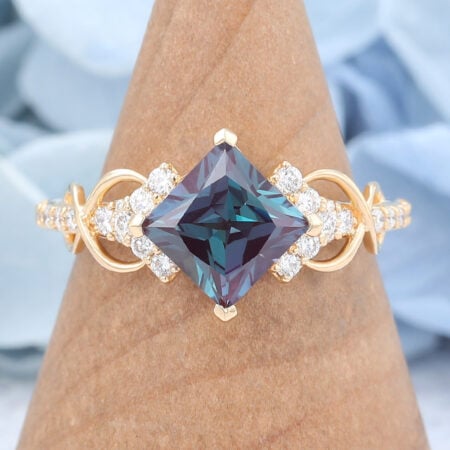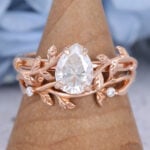Does Gold Scratch? Why It Happens and How to Prevent & Remove It
Gold has fascinated people for millennia with its rich color and radiant shine. While it’s a symbol of luxury and elegance, the softness of gold jewelry means that even everyday wear can leave tiny scratches. Many jewelry enthusiasts ask, does gold scratch, and understanding this helps you appreciate its beauty while learning how to care for it properly.
Understanding Gold Key Properties
Gold has been valued for millennia due to its rarity and captivating appearance. It has a density of approximately 19.3 grams per cubic centimeter, making it one of the heaviest common metals used in jewelry. Gold’s hardness on the Mohs scale is around 2.5 to 3, indicating it is relatively soft compared to other metals. Its melting point reaches 1,064 °C (1,947 °F), and it is highly ductile and malleable, allowing it to be drawn into thin wires or hammered into delicate sheets. These properties, combined with its natural corrosion resistance and distinctive yellow luster, have made gold a symbol of wealth and a preferred material for crafting jewelry throughout history.
Does Gold Scratch?
Many people wonder, does gold scratch easily. Real pure gold is a relatively soft metal, which makes its surface prone to scratches from everyday contact with harder materials. These scratches don’t affect the metal’s strength, but over time, they can dull the polished appearance of gold jewelry.
What Makes Gold Scratch-Prone?
Gold’s softness is the main reason it scratches easily. Its atomic structure allows the metal to deform under pressure, so even minor contact with objects like coins, keys, or rough fabrics can leave marks. While gold’s natural luster and malleability make it ideal for detailed jewelry designs, these same properties contribute to its susceptibility to surface scratches.
Common Situations That Cause Gold to Scratch
Keys and Coins: Contact with hard objects like keys, coins, or metal buttons can easily leave scratches on gold surfaces during everyday handling.
Household Chores: Cleaning, cooking, or washing dishes exposes gold jewelry to abrasive materials and surfaces, increasing the likelihood of minor scratches.
Sports and Physical Activities: Wearing gold during exercise or outdoor activities can cause friction against equipment, concrete, or other rough surfaces, leading to scuffs.
Storage and Travel: Placing gold pieces in a crowded jewelry box or tossing them into bags without protection can result in scratches from rubbing against other items.
Different Gold Types and Their Scratch Resistance
24K Gold (Solid or Pure Gold): Being nearly pure, 24K gold is very soft and scratches easily. Its bright yellow color is highly prized but requires careful handling to maintain a smooth surface.
22K Gold: Slightly harder than 24K, 22K gold is still relatively soft. It offers rich color while providing a bit more durability, though scratches can still appear with frequent wear.
18K Gold: Mixed with stronger metals, 18K gold has improved hardness and better scratch resistance. It balances a vibrant golden hue with practical durability for everyday jewelry.
14K Gold: With more alloyed metals, 14K gold is the hardest among commonly used jewelry golds. It resists scratches better while still maintaining a warm gold color, making it suitable for frequent wear.
10K Gold: Containing the highest proportion of alloyed metals, 10K gold is the most durable among common jewelry golds. It resists scratches well but has a slightly paler color compared to higher-karat golds.
Different Gold Colors (Yellow, White, Rose): Gold alloys can come in various colors, including classic yellow, elegant white, and romantic rose gold. Their scratch resistance largely depends on the types and proportions of metals mixed into the alloy rather than the color itself. For example, 14K gold contains more alloyed metals than 18K gold, making it harder and more resistant to scratches, even if both have the same color. Some color treatments or plating may slightly affect surface durability, but the underlying hardness is determined by the alloy composition.

How to Prevent Gold from Getting Scratched?
Store Jewelry Separately
Keep gold pieces in individual pouches or compartments to avoid contact with other jewelry or hard objects that can cause scratches.
Remove During Physical Activities
Take off gold jewelry during sports, exercise, or heavy manual work to minimize friction against surfaces or tools.
Avoid Harsh Chemicals
Household cleaners, cosmetics, and chlorine can weaken gold’s surface over time, making it more susceptible to scratches.
Clean Gently
Use soft cloths or mild jewelry cleaning solutions to remove dirt and oils. Avoid abrasive materials that can scratch the gold while cleaning.
Regular Maintenance
Periodically have gold pieces polished or inspected by a professional jeweler to maintain their smooth finish and address minor surface scratches before they worsen.
How to Remove Scratches from Gold Jewelry?
Polishing Cloths
Polishing gold jewellery with a soft jewelry polishing cloth to gently buff out minor scratches. This method works well for scratched gold with light surface marks and helps restore shine.
Professional Polishing
Take your gold jewelry to a professional jeweler for polishing or refinishing. They can remove deeper scratches and restore a smooth, polished surface.
Ultrasonic Cleaning
Some jewelers offer ultrasonic cleaning, which can help lift dirt and reduce the appearance of small scratches, though it won’t eliminate deep grooves.
Attention: Avoid using toothpaste, baking soda, or other abrasive household products, as they can worsen scratches or damage gold jewelry.
Why Gold Scratches Are Normal—and Manageable
Scratches on gold jewelry are a natural result of its softness and frequent contact with everyday objects. Even with careful handling, minor marks can appear over time. However, these scratches are largely cosmetic and do not affect the metal’s durability. By following simple preventive measures, such as storing jewelry separately, avoiding harsh surfaces, and scheduling occasional professional polishing, gold pieces can maintain their shine and elegance for years. Understanding that scratches are normal helps set realistic expectations and ensures proper care without unnecessary worry.
Conclusion: Keep Your Gold Jewelry Timeless
You might wonder, does gold scratch? It does—gold’s softness makes minor marks almost inevitable. The good news is that these scratches are easy to manage. With simple care, gentle cleaning, and occasional professional polishing, your gold jewelry can stay shiny and beautiful for years, letting you enjoy its timeless appeal without worry.
o.
FAQs About Does Gold Scratch
Does real solid gold scratch?
Yes, real solid gold is soft and can develop scratches from everyday contact with harder materials.
Why is gold so soft?
Gold’s atomic structure allows its layers to slide easily, making it naturally soft compared to most metals.
Do 10K, 14K, and 18K gold scratch easily?
Lower-karat gold like 10K is harder and more scratch-resistant, while higher-karat gold like 18K is softer and more prone to scratches.
How do you polish and buff gold?
Use a soft polishing cloth or take it to a professional jeweler for polishing to restore shine and reduce minor scratches.
Does platinum scratch easier than gold?
No, platinum is harder than pure gold and generally more resistant to scratches, though it can still show marks over time.
Does gold tarnish over time?
Pure gold does not tarnish, but gold alloys may develop slight discoloration depending on the metals mixed in.
Does gold-dipped or gold-filled jewelry tarnish?
Yes, gold-dipped or gold-filled jewelry can tarnish over time, especially with exposure to water, sweat, or chemicals.
Can 10K, 14K, and 18K gold get wet? Do they rust?
Yes, they can get wet. Gold itself does not rust, but alloys with other metals may discolor slightly if exposed frequently to moisture.
Can gold change color? Why does gold jewelry turn black?
Gold jewelry can darken due to oxidation of alloyed metals or reaction with chemicals like sulfur, causing a blackish appearance on the surface.



